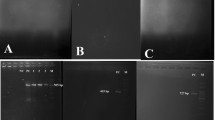Abstract
Nocardia cyriacigeorgica is a recently described species. During routine diagnostic testing of 121 clinical isolates, we found that about one fourth of the strains from Japan (19 isolates) and Thailand (8 isolates), which were identified in our laboratories as N. asteroides, in fact belong to N. cyriacigeorgica. To our knowledge, this is the first report of infection due to N. cyriacigeorgica in Japan and Thailand, and the third report of infection anywhere in the world. Although N. cyriacigeorgica is usually differentiated from other Nocardia species by utilization of glucose and gluconate, we found that it can also be differentiated by a characteristic synergistic effect between imipenem (IPM) and tobramycin (TOB).
Similar content being viewed by others
References
Javaly K, Horowitz HW, Wormser GP. Nocardiosis in patients with human immunodeficiency virus infection. Medicine (Baltimore) 1992; 128–138.
F Laurent A Carlotti Ribotyping Boiron P. (1996) ArticleTitleA tool for taxonomy and identification of the Nocardia asteroides complex species J. Clin. Microbiol. 34 1079–1082 Occurrence Handle8727879
VA Orchard M. Goodfellow (1980) ArticleTitleNumerical classification of some named strains of Nocardia asteroides and related isolates from soil J. Gen. Microbiol. 118 295–312 Occurrence Handle7003057
M. Goodfellow (1989) Nocardia and related genera A Balows BI Duerden (Eds) Topley and Wilson’s Microbiology and Microbial Infections, 9th edn, vol. 2, Systematic Bacteriology Arnold London 463–489
J Chun M. Goodfellow (1995) ArticleTitleA phylogenetic analysis of genus Nocardia with 16S rRNA gene sequences Int. J. Syst. Bacteriol. 45 240–245 Occurrence Handle7537058
B Albuquerque EVS Manfio GP Maitan VR Bataus LAM Kim SB Maldonado M. Goodfellow (2003) ArticleTitleNocardia cerradoensis sp. nov., a novel isolate from Cerrado soil in Brazil. Int J. Syst. Evol. Microbiol. 53 29–33 Occurrence Handle10.1099/ijs.0.02020-0
L Maldonado JV Hookey AC Ward M. Goodfellow (2000) ArticleTitleThe Nocardia salmonicida clade, including descriptions of Nocardia cummidelens sp. nov., Nocardia fluminea sp. nov. and Nocardia soli sp. nov Antonie Leeuwenhoek 78 367–377 Occurrence Handle10.1023/A:1010230632040 Occurrence Handle11386359
A Yassin F Rainey U. Stainer (2001) ArticleTitleNocardia cyriacigeorgici sp. nov Int. J. Syst. Evol. Microbiol. 51 1419–1423 Occurrence Handle11491341
RE Gordon DA Barnett JE Handerhan CHN. C. Pang (1974) ArticleTitleNocardia coeliaca, Nocardia autotrophica, and the nocardin strain. Int J. Syst. Bacteriol. 24 54–63
N Poonwan M Kusum Y Mikami K Yazawa Y Tanaka T Gonoi S Hasegawa K. Konyama (1995) ArticleTitlePathogenic Nocardia isolated from clinical specimens including those of AIDS patients in Thailand Eur. J. Epidemiol. 11 507–512 Occurrence Handle10.1007/BF01719301 Occurrence Handle8549723
Y. Mikami K. Yazawa (1989) ArticleTitleSusceptibility patterns of pathogenic Nocardia to some selected antimicrobial agents and their usefulness in the identification work in a clinical laboratory Bull JFCC 5 89–95
K Tasaka A Ishida T. Chinzei (2002) ArticleTitleAntimicrobial activity of carbapenems and the combined effect with aminoglycoside against recent clinical isolates of Pseudomonas aeruginosa Jpn. J. Antibiotic. 55 181–186
A Kageyama H Sato M Nagata K Yazawa M Katsu Y Mikami K Kamei K. Nishimura (2002) ArticleTitleFirst human case of nocardiosis caused by Nocardia pseudobrasiliensis in Japan Mycopathologia 156 187–192 Occurrence Handle10.1023/A:1023340624229 Occurrence Handle12749583
H Saito K. Miura (1983) ArticleTitlePreparation of transforming deoxyribonucleic acid by phenol treatment Biophys Acta 72 619–629 Occurrence Handle10.1016/0006-3002(63)90288-9
JD Thompson DG Higgins TJ. Gibson (1994) ArticleTitleCLUSTAL W: Improving the sensitivity of progressive multiple sequence alignment through sequence weighting, position specific gap penalties and weight matrix choice Nucleic. Acids. Res. 22 4673–4680 Occurrence Handle7984417
C Fux T Bodmer HR Ziswiler SL. Leib (2003) ArticleTitleNocardia cyriacigeorgici: First report of invasive human infection Dtsch. Med. Wochenschr. 128 1034–1041 Occurrence Handle10.1055/s-2003-39102 Occurrence Handle12807110
AF Yassin FA Rainey U Mendrock H Brzezinka KP. Schaal (2000) ArticleTitleNocardia abscessus sp. nov Int. J. Syst. Evol. Microbiol. 50 1487–1493 Occurrence Handle10939654
V Gurtler R Smith BC Mayall G Pötter-Reinemann E Stackebrandt M. Goodfellow (2001) ArticleTitleNocardia veterana sp. nov., isolated from human bronchial lavage Int. J. Syst. Evol. Microbiol. 51 933–936 Occurrence Handle11411717
ME Hamid L Maldonado GS Sharaf Eldin MF Mohamed NS Saeed M. Golloe (2001) ArticleTitleNocardia africana sp. nov., a new pathogen isolated from patients with pulmonary infections J. Clin. Microbiol. 39 625–630 Occurrence Handle10.1128/JCM.39.2.625-630.2001 Occurrence Handle11158119
D Young K Lee JH Yum HB Shin GM Rossolini Y. Chong (2002) ArticleTitleImipenem-EDTA disk method for differentiation for metallo- ß-lactamase-producing clinical isolates of Pseudomonas spp. and Acinetobacter spp J. Clin. Microbiol. 40 3798–37801 Occurrence Handle10.1128/JCM.40.10.3798-3801.2002 Occurrence Handle12354884
S Pournaras M Maniati E Petinaki LS Tzouvelekis A Tsakris NJ Legakis AN. Maniatis (2003) ArticleTitleHospital outbreak o multiple clones of Pseudomonas aeruginosa carrying the unrelated meatlo-ß-lactamase gene variants blaVIM-2 and blaVIM-4 J. Antimicrob. Chemother. 51 1409–1414 Occurrence Handle10.1093/jac/dkg239 Occurrence Handle12716773
Mercuri PS, Ishii Y, Ma L Rossolini GM, Luzzaro F, Amicosante G, Franceschini N, Galleni M. Clonal diversity and metallo-ß-lactamase production in clinical isolates of Stenotrophomonas maltophila. Microb. Drug. Resist. 2002; 193–200.
Author information
Authors and Affiliations
Corresponding author
Rights and permissions
About this article
Cite this article
Kageyama, A., Hoshino, Y., Yazawa, K. et al. Nocardia cyriacigeorgica is a significant pathogen responsible for nocardiosis in Japan and Thailand. Mycopathologia 160, 15–19 (2005). https://doi.org/10.1007/s11046-005-3050-2
Received:
Accepted:
Issue Date:
DOI: https://doi.org/10.1007/s11046-005-3050-2




